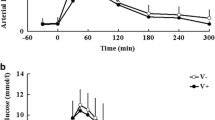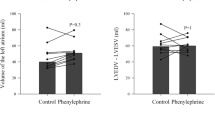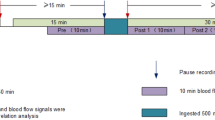Abstract
This study examined the influence of insulin and glucose on the transcapillary fluid absorption during lower body negative pressure (LBNP) in humans. Ten healthy males [23 (1) years] were exposed to LBNP of 45 cmH2O on two occasions: (1) before and during a hyperinsulinaemic clamp (HI) and (2) before and during a hyperglycaemic clamp (HG). Transcapillary fluid absorption and blood flow were recorded with volumetric technique. Forearm blood flow increased during HI from 2.3 (0.3) ml (100 ml)−1 min−1 to 3.3 (0.5) ml (100 ml)−1 min−1 (P<0.05). The haemodynamic response to LBNP was similar during HI and HG compared with control LBNP. Transcapillary fluid absorption during LBNP increased during HG from 0.044 (0.007) ml (100 ml)−1 min−1 to 0.059 (0.009) ml (100 ml)−1 min−1 (P<0.01), whereas it was unchanged during HI. In conclusion, hyperglycaemia augments transcapillary fluid absorption from skeletal muscle and skin during LBNP whereas hyperinsulinaemia has no such effect. This indicates that in human hyperglycaemia contributes to plasma volume restitution during hypovolaemic circulatory stress.



Similar content being viewed by others
References
Anderson EA, Hoffman RP, Balon TW, Sinkey CA, Mark AL (1991) Hyperinsulinaemia produces both sympathetic neural activation and vasodilatation in normal humans. J Clin Invest 87:2246–2252
Baron AD (1994) Hemodynamic action of insulin. Am J Physiol 267:E187–E202
Bauer W, Vigas SNM, Haist RE, Drucker WR (1969) Insulin during hypovolaemic shock. Surgery 66:80–88
Bonadonna RC, Saccomani MP, Del Prato S, Bonora E, DeFronzo RA, Cobelli C (1998) Role of tissue-specific blood flow and tissue recruitment in insulin-mediated glucose uptake of human skeletal muscle. Circulation 98:234–241
Cooper KE, Edholm OG, Mottram RF (1955) The blood flow in skin and muscle of the human forearm. J Physiol (Lond) 128:258–267
DeFronzo RA, Tobin JD, Andres R (1979) Glucose clamp technique: a method for quantifying insulin secretion and resistance. Am J Physiol 237:E214–E223
Drucker WR, Chadwick CDJ, Gann DS (1981) Transcapillary refill in hemorrhage and shock. Arch Surg 116:1344–1353
Dunne F, Barry D, Grealy G, Ferriss JB (1991) Home blood pressure monitoring devices: an evaluation of their performance. J Ambulatory Monit 4:275–280
Hafferl A (1957) Lehrbuch der topographischen Anatomie. Springer, Berlin Göttingen Heidelberg
Hall EH, Schwinghamer JM, Lalone B (1976) Mechanism of blood vessel constriction during hemorrhage. Am J Physiol 230:569–578
Hilstedt J, Christensen NJ, Larsen S (1989) Effects of catecholamines and insulin on plasma volume and intravascular mass of albumin in man. Clin Sci 77:149–155
Houben AJH, Schaper NC, De Haan CHA, Huvers FC, Slaff DW, De Leeuw PW, Nieuwenhuijzen Kruseman AC (1996) Local 24-h hyperglycaemia does not affect endothelium dependent or -independent vasoreactivity in humans. Am J Physiol 270:H2014–H2020
Järhult J (1973) Osmotic fluid transfer from tissue to blood during hemorrhagic hypotension. Acta Physiol Scand 89:213–226
Järhult J (1975) Role of the sympatho-adrenal system in hemorrhagic hyperglycaemia. Acta Physiol Scand 93:25–33
Kahn AM, Seidel CL, Allen JC, O'Neil RG, Shelat H, Song T (1993) Insulin reduces contraction and intracellular calcium contraction in vascular smooth muscle. Hypertension 22:735–742
Koya D, King GL (1998) Protein kinase C activation and the development of diabetic complications. Diabetes 47:859–866
Länne T, Edfeldt H, Quittenbaum S, Lundvall J (1992) Large capillary fluid permeability in skeletal muscle and skin in man as a basis for rapid beneficial fluid transfer between tissue and blood. Acta Physiol Scand 146:313–319
Lightenberg G, Blankenstijn PJ, Koomans HA (1998) Haemodynamic response during lower body negative pressure: role of volume status. J Am Soc Nephrol 9:105–113
Lundvall J, Länne T (1989) Large capacity in man for effective plasma volume control in hypovolaemia via fluid transfer from tissue to blood. Acta Physiol Scand 137:513–520
Maspers M, Björnberg J (1991) Beta2-adrenergic attenuation of capillary pressure autoregulation during haemorrhagic hypotension, a mechanism promoting transcapillary fluid absorption in skeletal muscle. Acta Physiol Scand 142:470–475
Maspers M, Björnberg J, Mellander S (1990) Relation between capillary pressure and vascular tone over the range from maximum dilatation to maximum constriction in cat skeletal muscle. Acta Physiol Scand 140:73–83
Mellander S (1960) Comparative studies of the adrenergic neuro-humoral control of resistance and capacitance blood vessels in the cat. Acta Physiol Scand 50 [Suppl 176]:1–86
Mellander S, Lewis D (1963) Effect of hemorrhagic shock on the reactivity of resistance and capacitance vessels and on capillary filtration transfer in cat skeletal muscle. Circ Res 13:105–118
Miller JA, Floras JS, Zinman B, Skorecki KL, Logan AG (1996) Effect of glucose on arterial pressure, plasma renin activity and renal function in early diabetes. Clin Sci 90:189–195
Muntzel MS, Thurnhost RL, Johnson AK (1997) Effects of subfornical lesions on sympathetic nerve responses to insulin. Hypertension 29:1020–1024
Olsen H, Länne T (2000) Reduced capillary hydraulic conductivity in skeletal muscle and skin in Type I diabetes: a possible cause for reduced transcapillary fluid absorption during hypovolaemia. Diabetologia 43:1178–1184
Olsen H, Hulthén UL, Länne T (1999) Reduced transcapillary fluid absorption from skeletal muscle and skin during hypovolaemia in insulin-dependent diabetes mellitus. J Intern Med 246:477–488
Olsen H, Vernersson E, Länne T (2000) Cardiovascular response to acute hypovolaemia in relation to age. Implications for orthostasis and haemorrhage. Am J Physiol 278:H222–H232
Parving HH, Noer I, Deckert T, Evrin PE, Nielsen SL, Lyngsøe J, Mogensen CE, Rørth M, Svendsen PAA, Trap-Jensen J, Lassen NA (1976) The effect of metabolic regulation on microvascular permeability to small and large molecules in short-term diabetics. Diabetologia 12:161–166
Sandeman D, Shore AC, Tooke JE (1992) Relation of skin capillary pressure in patients with insulin-dependent diabetes mellitus to complications and control. N Engl J Med 327:760–764
Shackford SR, Mackersie RC, Holbrook TL, Davis JW, Hollingworth-Fridlund P, Hoyt DB, Wolf PL (1993) The epidemiology of traumatic death. Arch Surg 128:571–575
Steinberg HO, Brechtel G., Johnson A, Fineberg N, Baron AD (1994) Insulin-mediated skeletal muscle vasodilatation is nitric oxide dependent. J Clin Invest 94:1172–1179
Tack CJJ, Schefman AEP, Willems JL, Thien T, Lutterman JA (1996a) Direct vasodilator effect of physiological hyperinsulinaemia in human skeletal muscle. Eur J Clin Invest 26:772–778
Tack CJJ, Smits P, Willemsen JJ, Lenders JWM, Thien T, Lutterman JA (1996b) Effects of insulin on vascular tone and sympathetic nervous system in NIDDM. Diabetes 45:15–22
Tilton RG, Kawamura T, Chang KC, Ido Y, Bjercke RJ, Stephan CC, Brock TA, Williamson JR (1997) Vascular dysfunction induced by elevated glucose levels in rats is mediated by vascular endothelial growth factor. J Clin Invest 99:2192–2202
Ware J, Norberg K-A, Nylander G (1983) Solute equilibrium over the extracellular fluid space in haemorrhagic hypotension: A study in a cannulated thoracic duct model. Eur Surg Res 15:256–261
Williams SB, Goldfine A, Timini FK, Ting HH, Roddy M-A, Simonson DC, Creager MA (1998) Acute hyperglycaemia attenuates endothelium-dependent vasodilation in humans in vivo. Circulation 97:1695–1701
Wolthius RA, Bergman SA, Nicogossian AE (1974) Physiological effects of locally applied reduced pressure in man. Physiol Rev 54:566–595
Acknowledgements
Grants from Novo Foundation, Denmark, the Medical Faculty, Lund University, the Medical Research Council (no. 12661), the Swedish Heart Lung Foundation and the Funds of Malmö University Hospital supported this study.
Author information
Authors and Affiliations
Corresponding author
Rights and permissions
About this article
Cite this article
Olsen, H., Groop, L. & Länne, T. Influence of glucose and insulin on transcapillary fluid absorption from the arm during lower body negative pressure in man. Eur J Appl Physiol 90, 138–143 (2003). https://doi.org/10.1007/s00421-003-0894-3
Accepted:
Published:
Issue Date:
DOI: https://doi.org/10.1007/s00421-003-0894-3




